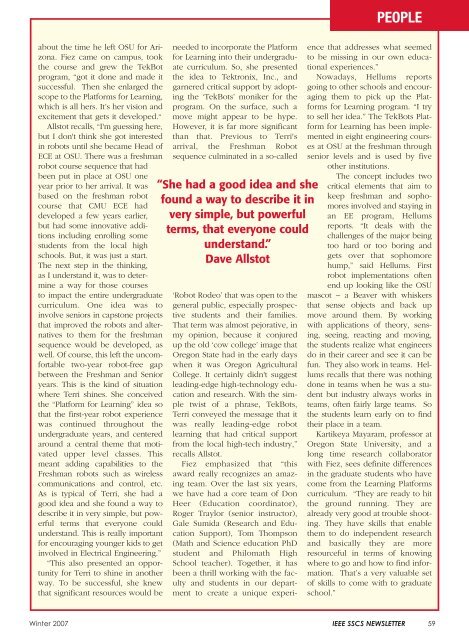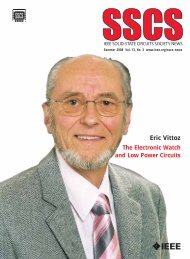The Impact of Dennard's Scaling Theory - IEEE
The Impact of Dennard's Scaling Theory - IEEE
The Impact of Dennard's Scaling Theory - IEEE
- TAGS
- scaling
- www.ieee.org
Create successful ePaper yourself
Turn your PDF publications into a flip-book with our unique Google optimized e-Paper software.
about the time he left OSU for Arizona.<br />
Fiez came on campus, took<br />
the course and grew the TekBot<br />
program, “got it done and made it<br />
successful. <strong>The</strong>n she enlarged the<br />
scope to the Platforms for Learning,<br />
which is all hers. It’s her vision and<br />
excitement that gets it developed.“<br />
Allstot recalls, “I'm guessing here,<br />
but I don't think she got interested<br />
in robots until she became Head <strong>of</strong><br />
ECE at OSU. <strong>The</strong>re was a freshman<br />
robot course sequence that had<br />
been put in place at OSU one<br />
year prior to her arrival. It was<br />
based on the freshman robot<br />
course that CMU ECE had<br />
developed a few years earlier,<br />
but had some innovative additions<br />
including enrolling some<br />
students from the local high<br />
schools. But, it was just a start.<br />
<strong>The</strong> next step in the thinking,<br />
as I understand it, was to determine<br />
a way for those courses<br />
to impact the entire undergraduate<br />
curriculum. One idea was to<br />
involve seniors in capstone projects<br />
that improved the robots and alternatives<br />
to them for the freshman<br />
sequence would be developed, as<br />
well. Of course, this left the uncomfortable<br />
two-year robot-free gap<br />
between the Freshman and Senior<br />
years. This is the kind <strong>of</strong> situation<br />
where Terri shines. She conceived<br />
the “Platform for Learning” idea so<br />
that the first-year robot experience<br />
was continued throughout the<br />
undergraduate years, and centered<br />
around a central theme that motivated<br />
upper level classes. This<br />
meant adding capabilities to the<br />
Freshman robots such as wireless<br />
communications and control, etc.<br />
As is typical <strong>of</strong> Terri, she had a<br />
good idea and she found a way to<br />
describe it in very simple, but powerful<br />
terms that everyone could<br />
understand. This is really important<br />
for encouraging younger kids to get<br />
involved in Electrical Engineering.”<br />
“This also presented an opportunity<br />
for Terri to shine in another<br />
way. To be successful, she knew<br />
that significant resources would be<br />
needed to incorporate the Platform<br />
for Learning into their undergraduate<br />
curriculum. So, she presented<br />
the idea to Tektronix, Inc., and<br />
garnered critical support by adopting<br />
the ‘TekBots’ moniker for the<br />
program. On the surface, such a<br />
move might appear to be hype.<br />
However, it is far more significant<br />
than that. Previous to Terri's<br />
arrival, the Freshman Robot<br />
sequence culminated in a so-called<br />
“She had a good idea and she<br />
found a way to describe it in<br />
very simple, but powerful<br />
terms, that everyone could<br />
understand.”<br />
Dave Allstot<br />
‘Robot Rodeo’ that was open to the<br />
general public, especially prospective<br />
students and their families.<br />
That term was almost pejorative, in<br />
my opinion, because it conjured<br />
up the old ‘cow college’ image that<br />
Oregon State had in the early days<br />
when it was Oregon Agricultural<br />
College. It certainly didn't suggest<br />
leading-edge high-technology education<br />
and research. With the simple<br />
twist <strong>of</strong> a phrase, TekBots,<br />
Terri conveyed the message that it<br />
was really leading-edge robot<br />
learning that had critical support<br />
from the local high-tech industry,”<br />
recalls Allstot.<br />
Fiez emphasized that “this<br />
award really recognizes an amazing<br />
team. Over the last six years,<br />
we have had a core team <strong>of</strong> Don<br />
Heer (Education coordinator),<br />
Roger Traylor (senior instructor),<br />
Gale Sumida (Research and Education<br />
Support), Tom Thompson<br />
(Math and Science education PhD<br />
student and Philomath High<br />
School teacher). Together, it has<br />
been a thrill working with the faculty<br />
and students in our department<br />
to create a unique experi-<br />
PEOPLE<br />
ence that addresses what seemed<br />
to be missing in our own educational<br />
experiences.”<br />
Nowadays, Hellums reports<br />
going to other schools and encouraging<br />
them to pick up the Platforms<br />
for Learning program. “I try<br />
to sell her idea.” <strong>The</strong> TekBots Platform<br />
for Learning has been implemented<br />
in eight engineering courses<br />
at OSU at the freshman through<br />
senior levels and is used by five<br />
other institutions.<br />
<strong>The</strong> concept includes two<br />
critical elements that aim to<br />
keep freshman and sophomores<br />
involved and staying in<br />
an EE program, Hellums<br />
reports. “It deals with the<br />
challenges <strong>of</strong> the major being<br />
too hard or too boring and<br />
gets over that sophomore<br />
hump,” said Hellums. First<br />
robot implementations <strong>of</strong>ten<br />
end up looking like the OSU<br />
mascot – a Beaver with whiskers<br />
that sense objects and back up<br />
move around them. By working<br />
with applications <strong>of</strong> theory, sensing,<br />
seeing, reacting and moving,<br />
the students realize what engineers<br />
do in their career and see it can be<br />
fun. <strong>The</strong>y also work in teams. Hellums<br />
recalls that there was nothing<br />
done in teams when he was a student<br />
but industry always works in<br />
teams, <strong>of</strong>ten fairly large teams. So<br />
the students learn early on to find<br />
their place in a team.<br />
Kartikeya Mayaram, pr<strong>of</strong>essor at<br />
Oregon State University, and a<br />
long time research collaborator<br />
with Fiez, sees definite differences<br />
in the graduate students who have<br />
come from the Learning Platforms<br />
curriculum. “<strong>The</strong>y are ready to hit<br />
the ground running. <strong>The</strong>y are<br />
already very good at trouble shooting.<br />
<strong>The</strong>y have skills that enable<br />
them to do independent research<br />
and basically they are more<br />
resourceful in terms <strong>of</strong> knowing<br />
where to go and how to find information.<br />
That’s a very valuable set<br />
<strong>of</strong> skills to come with to graduate<br />
school.”<br />
Winter 2007 <strong>IEEE</strong> SSCS NEWSLETTER 59




